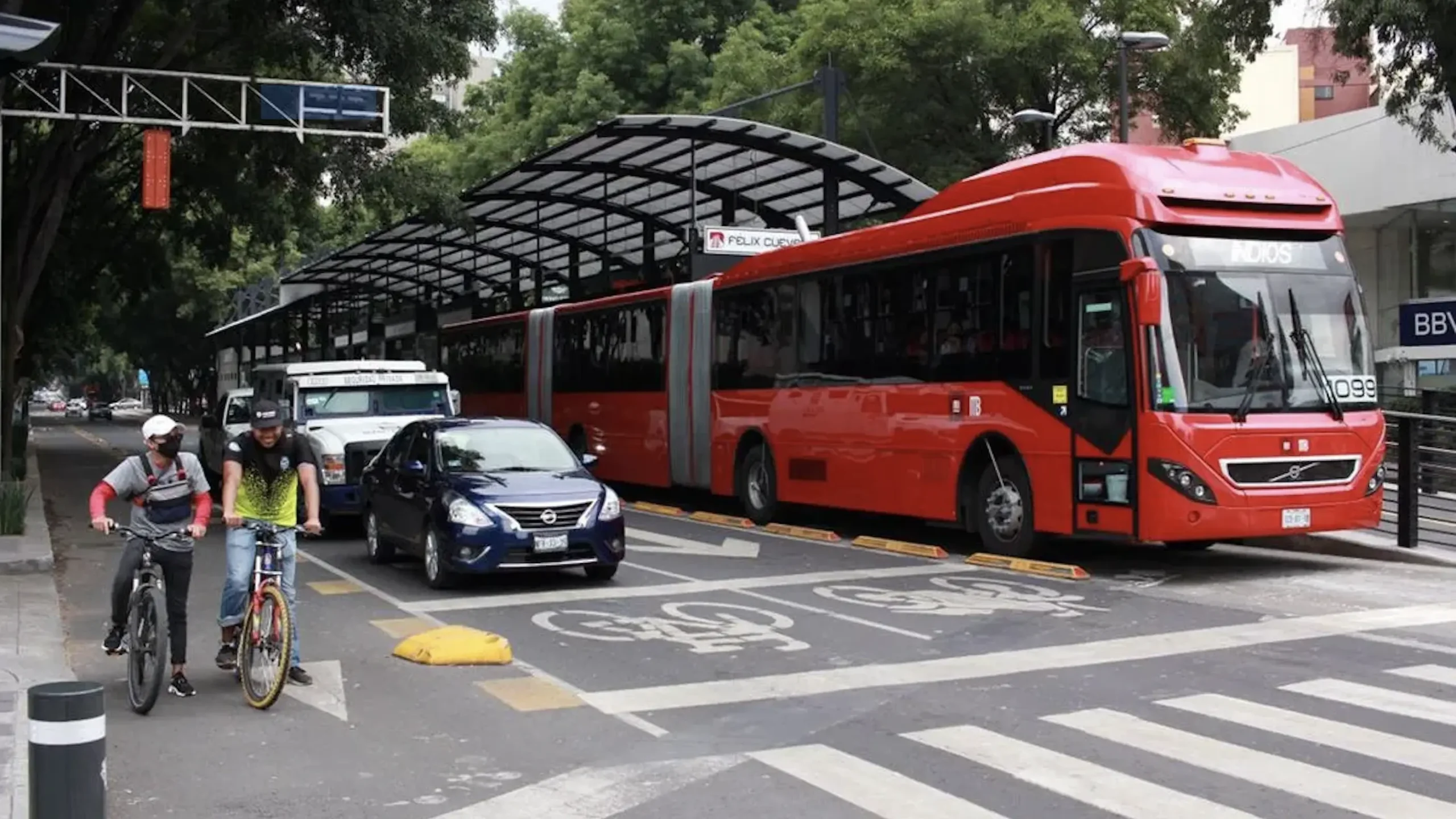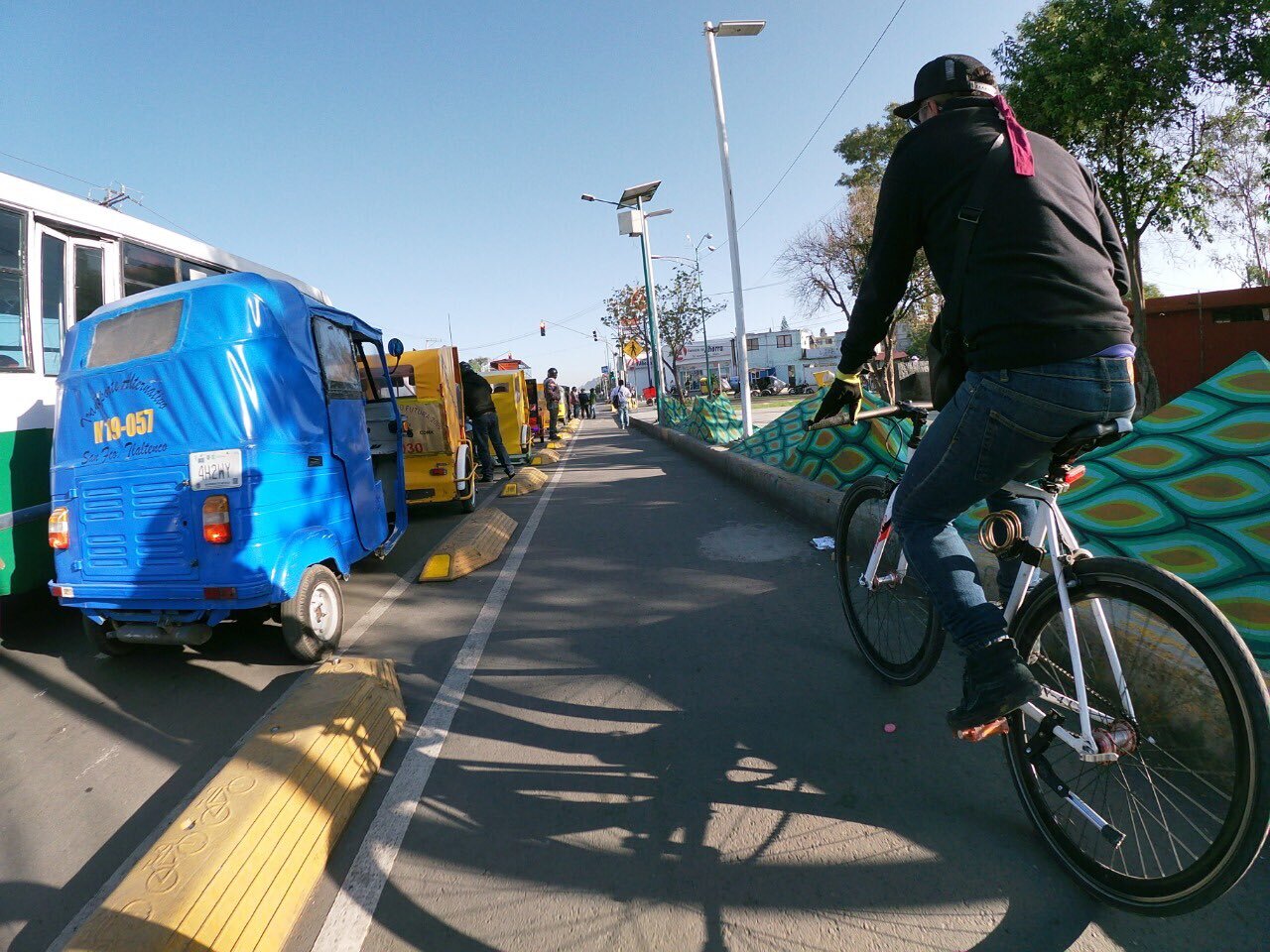On World Bicycle Day we’re celebrating streets built for people and sustainable transportation. As traffic deaths hit a 15-year high in the United States, Mexico City is showing what’s possible when a city uses a behavioral insights lens to guide its investments.
By considering every element of the road—and how people move through it—the city has shown how sustainable options can become the obvious choices. BIT Americas has seen these benefits first-hand from our new base in Mexico City. In this blog, we focus on three areas of progress: rapid mass transit, strong bicycle infrastructure, and physical transformations.
Investing in rapid mass transit
In 2005, Mexico City established a bus rapid transit system to reduce traffic congestion and pollution—and to offer people a new, faster transportation service. These eco-friendly, double-articulated Metrobuses bypass cars on their own exclusive lanes through the city’s busiest streets. They’ve decreased CO2 by 35,000 tons annually and reduced travel times for riders by 40 percent.
We see many behavioral insights in Metrobúses. For one, they’re easy to use. Bus platforms are on ground level (accessible to people on foot and wheels) and their wayfinding design is internationally recognized for providing a good user experience, making them easy to navigate. Tickets are also affordable and multiple payment options are accepted, including contactless payments, for quick and simple boarding.
They can also be faster than cars, especially in the high-traffic city center. Demand increased as a result, and the city responded with more buses and more lines. At seven lines transporting nearly 1.5 million riders daily, Metrobús shows that making public transportation more convenient than driving can successfully change transit behaviors.
This is key because we know how hard these behaviors can be to shift. For example, in 2017, the Massachusetts Institute of Technology (MIT) conducted a randomized controlled trial testing different incentives and messages encouraging employees to take the bus, walk, or bicycle to campus instead of drive. These interventions did not have a significant effect, in part because existing infrastructure couldn’t compete with the convenience of driving.

Mexico City has transformed its longest avenue into a complete street with exclusive spaces for public transportation, cycling, and pedestrians. (Image source: El Economista/SEMOVI CDMX)
Creating new Metrobús lines radically changes infrastructure for the better—and not only for mass transit users. For instance, when the pandemic began, the city took the opportunity to pilot a bicycle lane on the central section of Avenida de los Insurgentes, the location of the first Metrobús line and one of the longest avenues in Latin America. The lane increased bike trips by 275% and was made permanent, making Insurgentes a complete street with dedicated spaces for public transportation, cycling, and pedestrians.
Creating strong bicycle infrastructure
In urbanism, “induced demand” refers to the idea that growing roadway capacity (i.e., adding lanes) attracts more people to drive. Apparently, the same can happen if we increase public transportation capacity. The success of Metrobús shows that if a city has a new, fast, and convenient transit option, people will choose it. Using this same principle, Mexico City created ciclovías, or cycle lanes, to encourage people to bicycle.

Rubber curb stops (called “quesadillas” because of their shape) protect cyclists from cars. (Image source: Bitla MX)
Between 2019 and 2021, the city built 177 kilometers of permanent bicycle lanes, doubling the existing infrastructure of 165 kilometers of cycle lanes in just three years. The lanes are protected by rubber curb stops with perpendicular sides designed to block cars from crossing over and sloped sides to gently steer cyclists—making them safe for riders of all skill levels. To make it easier for people to take up cycling, the city is also expanding (almost doubling) its public bike share system, ECOBICI, at the same time. More than 9,300 bikes across 687 stations spanning six boroughs will be available to residents.
BIT explored the question of encouraging municipal bike share system use in 2019. We found that framing the offer of a bike share as “free” increased redemption, especially by people who recently moved to a neighborhood with a bike share station, compared to those already living near such an option. This shows that context changes can foster habitual commuting shifts.
Mexico City’s cycle network is popular among many people for many uses: commuting, delivering food and packages, selling tamales or bread, and recreation. Ciclovías have also attracted new cyclists, including families with young children, people exercising, and people in wheelchairs.
Transforming crosswalks for all
In Mexico City, nearly 8 out of 10 journeys are carried out on foot, bike, or public transportation. To help protect people, academics developed a crosswalk safety rating system for the city in 2019. Nearly 500 crosswalks were rated, and 91.3% did not meet safety standards for pedestrians. Many crosswalks were also inaccessible to people with limited mobility.
To make crosswalks universally accessible and to encourage driving behaviors that increase pedestrian safety, Cruces Seguros, or the Safe Crossings program, was created. Since the program began in April 2019, 114 crossings have been modified. These altered crosswalks are more visible at ground level (so that everyone can use them), protect pedestrians from turning cars with painted turn pockets, have new traffic lights, and more.
The first phase of the program saw a 20% reduction in traffic incidents, including 22% fewer injuries and 50% fewer deaths on modified crosswalks compared to before. The city continues to see safety and mobility grow as a result of the program.
The success of Cruces Seguros builds on the growing body of work that shows how simple changes to the built environment can increase pedestrian safety. For example, BIT modified 10 intersections in San Francisco using low-cost materials like paint and rubber speed bumps. The goal was to encourage drivers to make safer left turns, which accounted for 38% of the city’s traffic deaths in 2019. Our interventions slowed left turns by 17% (-1.7 mph)—improving safety for pedestrians and cyclists. There’s much more that can be done here.
Apply a behavioral insights lens
Mexico City is leading the way for sustainable transportation and streets built for people. As cities across North America think about ways they can encourage people to bike, walk, or take public transit, we encourage them to apply a behavioral insights lens to the challenge. With a holistic approach and interventions that start with physical alterations to streets, cities can direct resources toward solutions that make sustainable transportation the obvious choice—both in the short and long term. To learn more or discuss, please contact BIT here.






